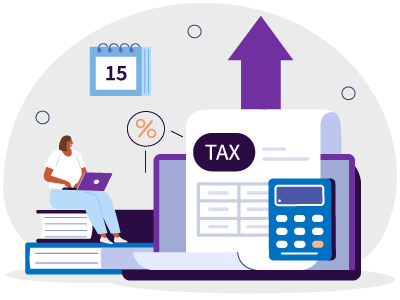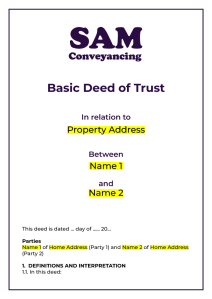Declaration of No Interest in Property
A Declaration of no interest in property is a legal document confirming that a person has no beneficial ownership or financial stake in a property, even if their name is on the legal title. This means they have no right to income from the property, proceeds from its sale, or any other benefits associated with ownership.
While joint property owners typically share beneficial interests, there are situations where a declaration of no interest is necessary. For example, during divorce or separation proceedings a court may order a declaration of no interest to keep both parties on the property's legal title and mortgage for practical reasons (such as maintaining mortgage approval) until a future date, even if one party has no financial stake in the property.
When is a declaration of no interest used?
Divorce or separation
During divorce or separation, a court may order a declaration of no interest to clarify the financial interest in a jointly owned property. This can be a temporary measure to maintain mortgage approvals or other practical arrangements until a final settlement is reached.
Stamp Duty Land Tax
A declaration of no interest is used in situations where multiple people are purchasing a property, but not all of them will have a beneficial ownership stake.
It's particularly relevant in Joint Borrower Sole Proprietor mortgages where parents assist their children with property purchases.
Tax planning for married couples
The declaration can be used alongside a Deed of Trust when sharing property income between spouses, often in conjunction with HMRC Form 17.
It's primarily used to split the income in a way that optimises both individual income tax liabilities, like where one spouse is in a lower tax bracket than the other.
Protection for unmarried couples
If an unmarried couple lives together in a property solely owned by one partner, a declaration of no interest can protect the sole owner from future claims of beneficial interest by the other partner. This prevents disputes if the relationship ends.
Business partnerships/investments
In some business partnerships or investment scenarios, one party might contribute funds towards a property purchase without intending to become a beneficial owner. A declaration of no interest can formalise this arrangement.
Protect your interest in a property and confirm how to sell. Drafted by a solicitor.
The first draft is within 1 to 2 working days* and includes:
- Deposit paid.
- The percentage ownership of each party.
- How to share expenses like the mortgage and bills.
- Share of property income - rent or gain on sale.
- How to sell the property.
- How the property is divided in the event of separation, divorce, or death.
The difference between a legal owner and a beneficial owner
What's the difference between legal and beneficial ownership? Legal ownership refers to who is registered as the owner of the property at the Land Registry. These are the names that appear on the title deeds.
Beneficial ownership, on the other hand, refers to who benefits from the property, such as receiving rental income or profits from its sale. A declaration of no interest confirms that someone listed as a legal owner has no right to these benefits, meaning they have no beneficial interest in the property.
For example, a parent might be listed as a legal owner on their child's mortgage to help them get approved for a loan. However, the parent may not intend to live in the property or receive any rental income from it. By signing a declaration of no interest, the parent legally confirms that they have no beneficial ownership, meaning they have no financial stake in the property beyond their role as a guarantor for the mortgage.
If you are planning on transferring beneficial interest to your married partner then these articles are essential reads:
- How to transfer ownership of house to wife or spouse
- Stamp duty on transfer of property between spouses
- Capital Gains Tax on Property for Married Couples
SDLT and declarations of no interest
With rising property prices, it's increasingly common for people to buy property jointly with parents or unmarried partners. However, this can create complex Stamp Duty Land Tax (SDLT) implications, especially if any of the purchasers already own a property.
The key issue is that if any of the joint purchasers already own or have previously owned another property, they may be subject to higher rates of SDLT or may not qualify for first-time buyer relief.
First-Time Buyer Relief
HMRC rules state that to qualify for first-time buyer relief (which can be up to £5,000), all purchasers must be first-time buyers. This means that if even one purchaser has previously owned a property, the relief cannot be claimed.
However, a declaration of no interest can be used in Joint Borrower Sole Proprietor mortgages to ensure that parents (who may already own property) do not count as beneficial owners, allowing the child to claim the relief if they are a first-time buyer.
Example: John and his parents are buying a house. John will live in the house and be the sole beneficial owner, but his parents are helping with the mortgage. By signing a declaration of no interest, his parents confirm they have no ownership stake, which may allow John to claim first-time buyer relief (if applicable).
Higher rates for additional dwellings
If any of the joint purchasers already own another property, they will typically be liable for the higher rates of SDLT (an additional 3% on top of the standard rates).
However, if one of the purchasers is only helping with the mortgage and has no beneficial interest in the property, a declaration of no interest can prevent these higher rates from applying. Often joint purchasers aren't looking to benefit from the transaction; the purpose is to help their child or partner get onto the property ladder using their joint salaries for the mortgage.
HMRC guidance (SDLTM09764) confirms this, stating that a purchaser with absolutely no beneficial interest will not be treated as a joint purchaser for SDLT purposes, provided this is evidenced in writing through a declaration of trust within a Deed of Trust.
Do you need a Declaration of No Interest? Our expert solicitors can help
Our specialist solicitors have extensive experience drafting legally sound and HMRC-compliant declarations of no interest for various purposes, including Stamp Duty Land Tax (SDLT), income tax, and divorce proceedings.
We understand the importance of speed and efficiency, so we aim to have a draft within one to two working days for just £245 INC VAT.
Declaration of no interest in divorce proceedings
During divorce or separation proceedings, a court may issue an order stipulating that the family home remains in the joint legal names of both parties, while simultaneously declaring that one party (for example, the wife) holds 100% of the beneficial interest.
During divorce proceedings a judge may make an order for the family home to remain in the joint names of the couple, however, the property is beneficially owned 100% by the wife.
The court order will typically include a declaration of no interest, formally confirming that the other party (in this example, the husband) has no beneficial interest and may also specify a future date for the transfer of legal title, if applicable.
This arrangement is often used to maintain stability for any children involved or to facilitate mortgage arrangements until a final financial settlement is reached.
Example: During their divorce, a court orders that the family home remains in both John's and Jane's names for the sake of their children, but Jane has sole beneficial ownership. A Declaration of No Interest confirms that John has no financial stake in the property, even though his name remains on the title temporarily.
Income tax and declarations of no interest
Declarations of no Interest (often implemented via a Deed of Trust) can be a valuable tool for tax planning, particularly for married couples who jointly own property and wish to share rental income in a tax-efficient manner.
If a married couple jointly owns a property and wishes to be taxed on their actual share of the rental income (known as the 'actual basis'), HMRC requires this arrangement to be formally documented and reported using Form 17.
Example: Sarah and Mark own a rental property. Sarah is a higher-rate taxpayer, while Mark is a basic-rate taxpayer. By using a declaration of no interest via a Deed of Trust or Deed of Assignment, they can allocate a larger portion of the rental income to Mark, potentially reducing their overall tax burden.
HMRC explicitly states that a verbal agreement is not sufficient. To support a Form 17 declaration, you must provide evidence of the unequal beneficial interests, such as a declaration of no interest or, more commonly, a Deed of Trust. This legal document confirms the agreed-upon split of beneficial ownership and therefore the allocation of rental income for tax purposes.
Declaration of no interest for protection
It's not always top of mind when moving in together, but unmarried couples should consider drafting a declaration of no interest via a Deed of Trust if one partner solely owns the property.
Unlike married couples, unmarried couples do not have the same automatic legal protections regarding property ownership. This means that if the relationship ends, disputes over property ownership can arise, even if only one partner is on the legal title.
The partner moving in could potentially make a future claim to a share of the property's beneficial interest based on their contributions (financial or otherwise), which is known as establishing a Constructive Trust – a legal concept where a court may recognise a beneficial interest even if it's not explicitly stated in writing.
Example: Lisa owns her flat. Her boyfriend, David, moves in and contributes to household bills and some mortgage payments. Without a declaration of no interest, David might later claim a share of the property based on his contributions. The declaration clarifies that he has no ownership stake and prevents potential future disputes.
Protect your interest in a property and confirm how to sell. Drafted by a solicitor.
The first draft is within 1 to 2 working days* and includes:
- Deposit paid.
- The percentage ownership of each party.
- How to share expenses like the mortgage and bills.
- Share of property income - rent or gain on sale.
- How to sell the property.
- How the property is divided in the event of separation, divorce, or death.
Andrew started his career in 2000 working within conveyancing solicitor firms and grew hands-on knowledge of a wide variety of conveyancing challenges and solutions. After helping in excess of 50,000 clients in his career, he uses all this experience within his article writing for SAM, mainstream media and his self published book How to Buy a House Without Killing Anyone.
Caragh is an excellent writer and copy editor of books, news articles and editorials. She has written extensively for SAM for a variety of conveyancing, survey, property law and mortgage-related articles.










